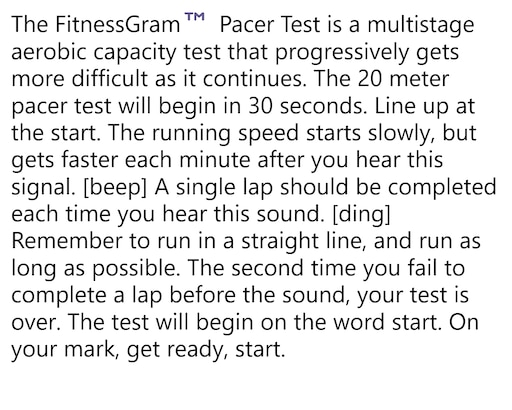The FitnessGram Pacer Test Lyrics, often recognized by its rhythmic beeps and the familiar stress it invokes in students, is more than just a challenging endurance drill. Its structured cadence and progressively intense pace have made it a staple in physical education programs across the globe. But beyond its reputation, what truly is the Pacer Test, and why do the lyrics resonate so strongly with participants? Let’s dive into the nitty-gritty of this endurance test, break down its iconic lyrics, and explore its broader significance.
What is the Fitnessgram Pacer Test?
The Fitnessgram Pacer Test, or the Progressive Aerobic Cardiovascular Endurance Run (PACER), was developed in the 1980s by Dr. Lyle Mitchell, a physical education specialist. Its primary goal is to assess the aerobic capacity of participants, typically students, through a multi-stage running challenge. Participants run back and forth across a 20-meter distance at increasing speeds, gauged by timed beeps. The test is part of the Fitnessgram assessment, which includes various physical fitness evaluations to provide a comprehensive view of a student’s health and fitness levels.
The Structure of the FitnessGram Pacer Test
Initial Stages
At the beginning, the Pacer Test starts off at a manageable pace. The initial stages are designed to ease participants into the rhythm of the test, building their confidence and ensuring they understand the procedure. This phase is crucial as it helps participants acclimate to the format and set their initial pacing.
Increasing Difficulty
FitnessGram Pacer As the test progresses, the intervals between beeps shorten, requiring participants to increase their running speed. This gradual increase in difficulty tests both the physical and mental endurance of the participants. The beeps become more frequent, challenging participants to push their limits and maintain a faster pace.
Final Stages
In the final stages, the pace becomes quite challenging. This is where the true test of aerobic capacity and stamina comes into play. Many participants find these stages to be the most daunting, as they push their limits to keep up with the beeps. The final stages often separate those with superior endurance and mental fortitude from those who might not have prepared as thoroughly.
The Role of Music in the FitnessGram Pacer Test
Impact on Performance
Music is a key element in the Pacer Test. The rhythmic beeps and background music help set the pace and motivate participants to keep moving. Studies have shown that music can significantly enhance physical performance by improving mood and reducing the perception of effort. The steady rhythm provides a consistent pace for participants to follow, helping them synchronize their movements and maintain consistency.
Significance of the FitnessGram Pacer Lyrics
The lyrics of the Pacer Test are straightforward but highly effective in communicating the test’s requirements and maintaining participants’ focus. Each line serves as a reminder of the rules and expectations, providing clarity and encouragement. The repetitive nature of the instructions ensures that participants are constantly reminded of the test’s parameters, which can help reduce anxiety and confusion.
Breaking Down the FitnessGram Pacer Test Lyrics

Introduction to the Lyrics
The lyrics of the FitnessGram Pacer Test are designed to guide participants through the test. They are simple yet precise, ensuring that everyone understands what is required at each stage of the test. By breaking down each line, we can see how the lyrics play a crucial role in keeping participants informed and motivated.
Detailed Explanation of the Lyrics
“The FitnessGram Pacer Test is a multistage aerobic capacity test”
This opening line sets the stage for the test, informing participants that they are about to undertake a rigorous challenge designed to measure their aerobic fitness. It’s a straightforward declaration of what the test entails, helping participants understand the purpose of the upcoming activity.
“It progressively gets more difficult as it continues”
FitnessGram Pacer This line prepares participants mentally for the increasing difficulty, emphasizing the importance of pacing themselves and conserving energy for later stages. By highlighting the progressive nature of the test, participants are reminded that the challenge will intensify, encouraging them to manage their energy efficiently.
“The 20-meter pacer test will begin in 30 seconds”
The countdown serves as a preparatory phase, giving participants a moment to focus and get into the starting position. It’s a crucial time to mentally and physically prepare for the task ahead. This brief pause allows participants to center themselves, reducing initial anxiety and setting a calm, focused tone for the start.
“Line up at the start”
This instruction ensures that all participants are ready and aligned correctly, fostering a sense of order and readiness. By instructing participants to line up, FitnessGram Pacer the test administrators ensure that everyone begins on an equal footing, both literally and figuratively.
“The running speed starts slowly, but gets faster each minute”
This line outlines the pacing strategy, reassuring participants that the test will start at an easy pace. It helps in mentally preparing them for the gradual increase in speed. Understanding that the pace will start slow can help alleviate initial stress, allowing participants to find their rhythm early on.
“A single lap should be completed each time you hear this sound”
The beep serves as an auditory cue for each lap, helping participants synchronize their runs with the rhythm of the test. It’s crucial for maintaining the correct pace. FitnessGram Pacer By following the sound, participants can ensure they are on track, reducing the likelihood of falling behind.
“Remember to run in a straight line”
Maintaining a straight line while running is important for efficiency and to avoid collisions. This reminder helps participants conserve energy and stay focused. Running in a straight line minimizes the distance covered, ensuring that participants are not expending unnecessary energy.
“The second time you fail to complete a lap before the sound, your test is over”
This line explains the termination criteria, motivating participants to push themselves and complete each lap on time. It emphasizes the importance of consistency and endurance. Knowing that the test will end after two misses adds a layer of urgency, encouraging participants to give their best effort continuously.
Impact of the Pacer Test on Fitness
The Pacer Test is an excellent measure of aerobic capacity, which is a crucial component of overall fitness. Regular participation in the test can significantly improve cardiovascular health, endurance, and physical performance. The test not only challenges the cardiovascular system but also improves muscle endurance and overall stamina.
Preparing for the FitnessGram Pacer Test
Training Tips and Strategies
- Interval Training: Incorporate interval running into your routine to build speed and endurance. Alternate between high-intensity sprints and lower-intensity recovery periods to simulate the varying speeds of the Pacer Test.
- Stamina Building: Engage in activities like cycling, swimming, or long-distance running to improve overall stamina. These exercises help build the aerobic capacity needed to excel in the Pacer Test.
- Pacing Practice: Practice running at different paces to get used to adjusting your speed as required in the test. Familiarity with varying speeds can help you maintain the correct pace during the test.
- Strength Training: Incorporate strength training exercises to build muscle endurance. FitnessGram Pacer Stronger muscles can help improve overall performance and reduce fatigue.
- Flexibility and Mobility: Include stretching and mobility exercises in your routine to improve flexibility. This can enhance your running form and reduce the risk of injuries.
Physical and Mental Preparation
- Stay Hydrated: Ensure you are well-hydrated before the test. Proper hydration is crucial for maintaining energy levels and preventing cramps.
- Balanced Diet: Maintain a diet rich in complex carbohydrates, proteins, and healthy fats to fuel your body. Eating a balanced meal a few hours before the test can provide the necessary energy.
- Mental Focus: Use visualization techniques to prepare mentally for the increasing difficulty of the test. Visualize yourself successfully completing each stage to build confidence and reduce anxiety.
- Rest and Recovery: Ensure you get adequate rest before the test. A well-rested body performs better and is less prone to fatigue.
Common Misconceptions About the Pacer Test
Addressing Myths and False Beliefs
- Myth: The Pacer Test is only for athletes.
- Reality: The Pacer Test is designed for all fitness levels. It is a measure of aerobic capacity, not just athletic prowess.
- Myth: The Pacer Test is dangerous for children.
- Reality: When conducted properly, the Pacer Test is safe for children. It is designed to progressively challenge students while allowing them to stop if they feel uncomfortable.
- Myth: You must sprint throughout the Pacer Test.
- Reality: The test starts at a slow pace and gradually increases in speed. It is important to pace yourself rather than sprint from the start.
- Myth: Failing the Pacer Test means you are unfit.
- Reality: The Pacer Test is just one measure of aerobic capacity. Failing the test does not mean you are unfit; it highlights areas for improvement.
Clarifying the Test’s Purpose and Method
The FitnessGram Pacer Test aims to measure aerobic capacity, not to judge overall fitness. It is a tool to help individuals understand their current fitness level and identify areas for improvement. The test provides valuable data that can inform personalized fitness plans and track progress over time.
Case Studies and Personal Experiences
Testimonials from Participants
Many participants have shared their experiences with the FitnessGram Pacer Test, highlighting its impact on their fitness journey. Here are a few stories:
- John’s Story: John, a high school student, initially struggled with the Pacer Test. Through consistent training and mental preparation, he improved his score significantly. He credits the test with helping him build endurance and confidence.
- Sarah’s Story: Sarah, a middle school teacher, implemented the FitnessGram Pacer Test in her PE classes. She observed significant improvements in her students’ fitness levels and noted increased motivation and participation in physical activities.
- Mark’s Story: Mark, a recreational runner, used the Pacer Test to gauge his aerobic capacity. He found the test challenging but rewarding, as it helped him identify areas for improvement and set realistic fitness goals.
Real-life Stories of How the Test Has Impacted Individuals
The Pacer Test has had a profound impact on many individuals, from students to athletes. It has helped them build endurance, improve cardiovascular health, and develop a greater appreciation for physical fitness. By setting clear goals and tracking progress, participants have been able to achieve significant improvements in their overall fitness levels.
The Pacer Test in Different Environments
Variations in School Settings
The Pacer Test is commonly used in school physical education programs, but its implementation can vary. Some schools incorporate it as part of a larger fitness assessment, while others use it as a standalone test. The test can be adapted to different age groups and fitness levels, ensuring it is appropriate for all students.
Adaptations for Special Populations
The Pacer Test can be modified to accommodate individuals with special needs or limitations. FitnessGram Pacer Adaptations might include shorter distances, longer intervals, or alternative activities that measure aerobic capacity. These modifications ensure that everyone can participate and benefit from the test.
Future of the Fitnessgram Pacer Test

Potential Changes and Updates
As research in physical fitness and education evolves, the Pacer Test may undergo changes to improve its effectiveness and inclusivity. Potential updates could include new pacing strategies, enhanced audio cues, or integration with digital tracking tools to provide more detailed feedback.
Ongoing Research and Development
Researchers continue to study the Pacer Test to better understand its impact on fitness and its role in physical education. Ongoing research may lead to new insights and improvements, ensuring the test remains a valuable tool for assessing aerobic capacity.
Conclusion
The Fitnessgram Pacer Test, with its rhythmic beeps and straightforward lyrics, is more than just a fitness challenge. It’s a comprehensive test of endurance, mental fortitude, and aerobic capacity. By understanding the lyrics and preparing adequately, participants can not only perform better but also gain significant health benefits. The test provides valuable data that can inform personalized fitness plans and track progress over time.
FAQs
What is the purpose of the Fitnessgram Pacer Test?
The purpose is to measure the aerobic capacity and endurance of participants, often used in school physical education programs.
How often should I practice for the Pacer Test?
It’s beneficial to include aerobic exercises like running or cycling in your routine at least 3-4 times a week to build stamina and endurance.
Can adults take the Pacer Test?
Yes, adults can take the Pacer Test. It’s a good measure of cardiovascular fitness for people of all ages.
What should I eat before the test?
A balanced meal with complex carbohydrates, proteins, and healthy fats consumed a few hours before the test can provide the necessary energy.
How can I improve my performance on the Pacer Test?
Regular aerobic exercise, interval training, and proper mental preparation can help improve performance on the Pacer Test.
